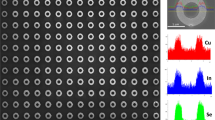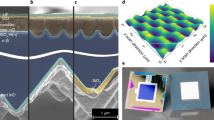Abstract
Dye-sensitized solar cells consist of a random network of titania nanoparticles that serve both as a high-surface-area support for dye molecules and as an electron-transporting medium. Despite achieving high power conversion efficiencies, their performance is limited by electron trapping in the nanoparticle film. Electron diffusion lengths can be increased by transporting charge through highly ordered nanostructures such as titania nanotube arrays. Although titania nanotube array films have been shown to enhance the efficiencies of both charge collection and light harvesting, it has not been possible to grow them on transparent conducting oxide glass with the lengths needed for high-efficiency device applications (tens of micrometres). Here, we report the fabrication of transparent titania nanotube array films on transparent conducting oxide glass with lengths between 0.3 and 33.0 µm using a novel electrochemistry approach. Dye-sensitized solar cells containing these arrays yielded a power conversion efficiency of 6.9%. The incident photon-to-current conversion efficiency ranged from 70 to 80% for wavelengths between 450 and 650 nm.
This is a preview of subscription content, access via your institution
Access options
Subscribe to this journal
Receive 12 print issues and online access
$259.00 per year
only $21.58 per issue
Buy this article
- Purchase on Springer Link
- Instant access to full article PDF
Prices may be subject to local taxes which are calculated during checkout




Similar content being viewed by others
References
Gratzel, M. Photoelectrochemical cells. Nature 414, 338–344 (2001).
O'Regan, B. & Gratzel, M. A low cost, high-efficiency solar cell based on dye-sensitized colloidal TiO2 films. Nature 353, 737–740 (1991).
Nazeeruddin, M. K. et al. Combined experimental and DFT-TDDFT computational study of photoelectrochemical cell ruthenium sensitizers. J. Am. Chem. Soc. 127, 16835–16847 (2005).
Fisher, A. C., Peter, L. M., Ponomarev, E. A., Walker, A. B. & Wijayanta, K. G. U. Intensity dependence of the back reaction and transport of electrons in dye-sensitized nanocrystalline TiO2 solar cells. J. Phys. Chem. B 104, 949–958 (2000).
Nazeeruddin, M. K. et al. Conversion of light to electricity by cis-X2bis(2,2′-bipyridyl-4,4′-decarboxylate)ruthenium(II) charge-transfer sensitizers (X = Cl−, Br−, I−, CN− and SCN−) on nanocrystalline TiO2 electrodes. J. Am. Chem. Soc. 115, 6382–6390 (1993).
Law, M., Greene, L. E., Johnson, J. C., Saykally, R. & Yang, P. Nanowire dye-sensitized solar cells. Nature Mater. 4, 455–459 (2005).
Adachi, M., Murata, Y., Okada, I. & Yoshikawa, S. Formation of titania nanotubes and applications for dye-sensitized solar cells. J. Electrochem. Soc. 150, G488–G493 (2003).
Feng, X. J. et al. Vertically aligned single crystal TiO2 nanowire arrays grown directly on transparent conducting oxide coated glass: synthesis details and applications. Nano Lett. 8, 3781–3786 (2008).
Varghese, O. K., Paulose, M., LaTempa, T. J. & Grimes, C. A. High-rate solar photocatalytic conversion of CO2 and water vapor to hydrocarbon fuels. Nano Lett. 9, 731–737 (2009).
Mor, G. K., Varghese, O. K., Paulose, M., Shankar, K. & Grimes, C. A. A review on highly ordered, vertically oriented TiO2 nanotube arrays: fabrication, material properties and solar energy applications. Sol. Energy Mater. Sol. Cells 14, 2011–2075 (2006).
Zhu, K., Neale, N. R., Miedaner, A. & Frank, A. J. Enhanced charge-collection efficiencies and light scattering in dye-sensitized solar cells using oriented TiO2 nanotube arrays. Nano Lett. 7, 69–74 (2007).
Jennings, J. R., Ghicov, A., Peter, L. M., Schmuki, P. & Walker A. B. Dye-sensitized solar cells based on oriented TiO2 nanotube arrays: transport, trapping and transfer of electrons. J. Am. Chem. Soc. 130, 13364–13372 (2008).
Paulose, M. et al. Anodic growth of highly ordered TiO2 nanotube arrays to 134 µm in length. J. Phys. Chem. B 110, 16179–16184 (2006).
Paulose, M. et al. TiO2 nanotube arrays of 1,000 µm in length by anodization of titanium foil: phenol red diffusion. J. Phys. Chem. C 111, 14992–14997 (2007).
Ito, S. et al. High efficiency (7.2%) flexible dye-sensitized solar cells with Ti-metal substrate for nanocrystalline-TiO2 photoanode. Chem. Commun. 4004–4006 (2006).
Shankar, K. et al. Highly-ordered TiO2 nanotube arrays up to 220 µm in length: use in water photoelectrolysis and dye-sensitized solar cells. Nanotechnology 18, 065707 (2007).
Chen, C. C. et al. Fabrication and characterization of anodic titanium oxide nanotube arrays of controlled length for highly efficient dye-sensitized solar cells. J. Phys. Chem. C 112, 19151–19157 (2008).
Park, J. H., Lee, T.-W. & Kang, M. G. Growth, detachment and transfer of highly-ordered TiO2 nanotube arrays: use in dye-sensitized solar cells. Chem. Commun. 2867–2869 (2008).
Chen, Q. & Xu, D. Large-scale, noncurling, and free-standing crystallized TiO2 nanotube arrays for dye-sensitized solar cells. J. Phys. Chem. C 113, 6310–6314 (2009).
Mor, G. K., Shankar, K., Paulose, M., Varghese, O. K. & Grimes, C. A. Use of highly-ordered TiO2 nanotube arrays in dye-sensitized solar cells. Nano Lett. 6, 215–218 (2006).
Paulose, M., Shankar, K., Varghese, O. K., Mor, G. K. & Grimes, C. A. Application of highly-ordered TiO2 nanotube-arrays in heterojunction dye-sensitized solar cells. J. Phys. D 39, 2498–2503 (2006).
Mor, G. K., Varghese, O. K., Paulose, M. & Grimes, C. A. Transparent highly ordered TiO2 nanotube arrays via anodization of titanium thin films. Adv. Funct. Mater. 15, 1291–1296 (2005).
Zhu, K., Vinzant, T. B., Neale, N. R. & Frank, A. J. Removing structural disorder from oriented TiO2 nanotube arrays: reducing the dimensionality of transport and recombination in dye-sensitized solar cells. Nano Lett. 7, 3739–3746 (2007).
Skeldon, P., Thompson, G. E., Garcia-Vergara, S. J., Iglesias-Rubianes, L. & Blanco-Pinzon, C. E. A tracer study of porous anodic alumina. Electrochem. Sol. State Lett. 9, B47–B51 (2006).
Prakasam, H. E., Shankar, K., Paulose, M., Varghese, O. K. & Grimes, C. A. A new benchmark for TiO2 nanotube array growth by anodization. J. Phys. Chem. C 111, 7235–7241 (2007).
Sommeling, P. M. et al. Influence of a TiCl4 post-treatment on nanocrystalline TiO2 films in dye-sensitized solar cells. J. Phys. Chem. B 110, 19191–19197 (2006).
Gratzel, M. Conversion of sunlight to electric power by nanocrystalline dye-sensitized solar cells. J. Photochem. Photobiol. A 164, 3–14 (2004).
Acknowledgements
The authors acknowledge support for this work from the Department of Energy, grant no. DE-FG36-08GO18074.
Author information
Authors and Affiliations
Contributions
M.P. conceived the idea, developed the anodization process and performed SEM imaging as well as DSC fabrication and characterization. O.K.V. conceived the idea and developed the process for coating titanium films, performed optical and structural studies as well as quantum efficiency measurements and composed the manuscript. M.P. and O.K.V. analysed the data. C.A.G. motivated and coordinated the work, supplied materials and analysis tools, and edited the manuscript.
Corresponding author
Supplementary information
Supplementary information
Supplementary information (PDF 422 kb)
Rights and permissions
About this article
Cite this article
Varghese, O., Paulose, M. & Grimes, C. Long vertically aligned titania nanotubes on transparent conducting oxide for highly efficient solar cells. Nature Nanotech 4, 592–597 (2009). https://doi.org/10.1038/nnano.2009.226
Received:
Accepted:
Published:
Issue Date:
DOI: https://doi.org/10.1038/nnano.2009.226
This article is cited by
-
Tube length optimization of titania nanotube array for efficient photoelectrochemical water splitting
Scientific Reports (2023)
-
CdS-deposited titania nanotubes array heterostructures and its investigation for photocatalytic application under visible light
Bulletin of Materials Science (2022)
-
A photoanode with hierarchical nanoforest TiO2 structure and silver plasmonic nanoparticles for flexible dye sensitized solar cell
Scientific Reports (2021)
-
Scalable synthesis of smooth PS@TiO2 core-shell and TiO2 hollow spheres in the (sub) micron size range: understanding synthesis and calcination parameters
Colloid and Polymer Science (2020)
-
The remarkable morphology regulatory effect of NH4+ ions on TiO2 nanorod arrays and their application in dye-sensitized solar cells
Applied Physics A (2019)



